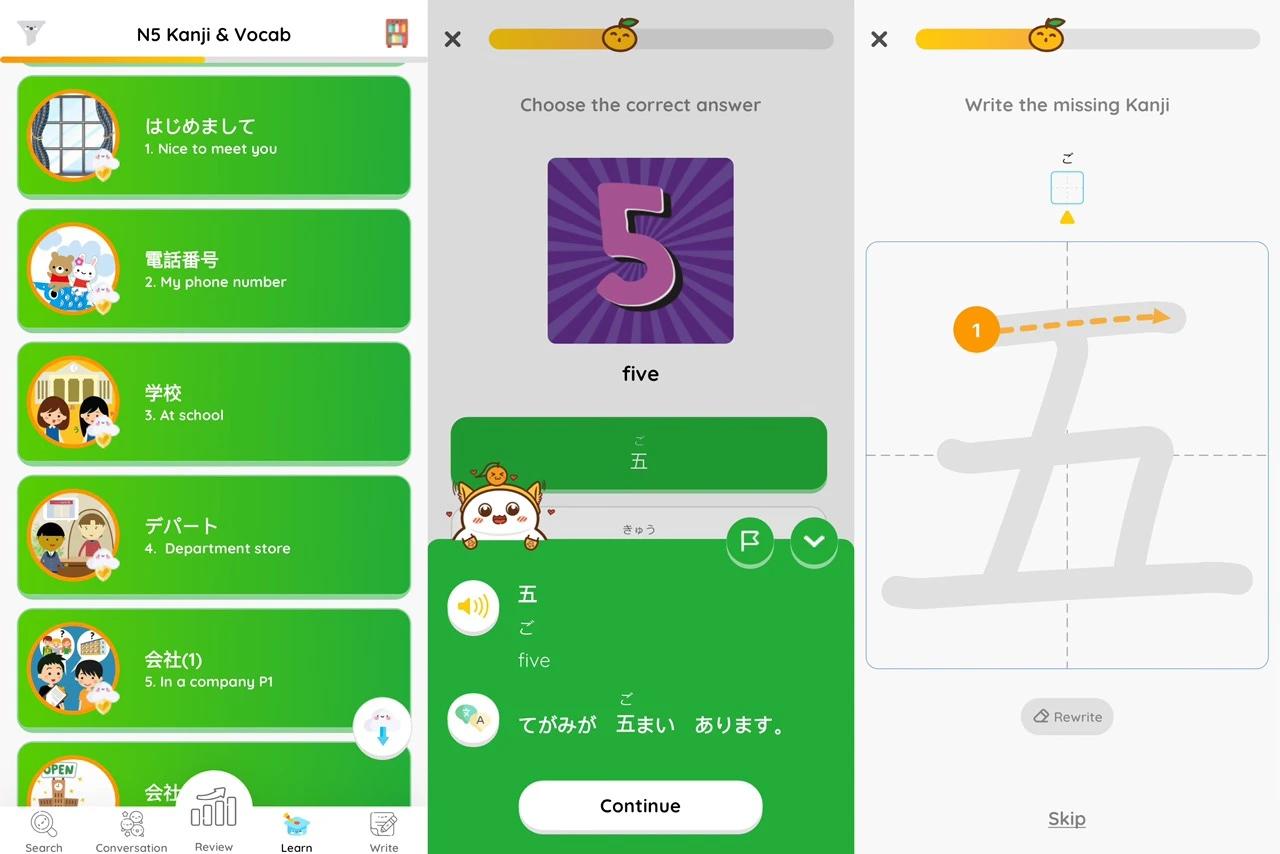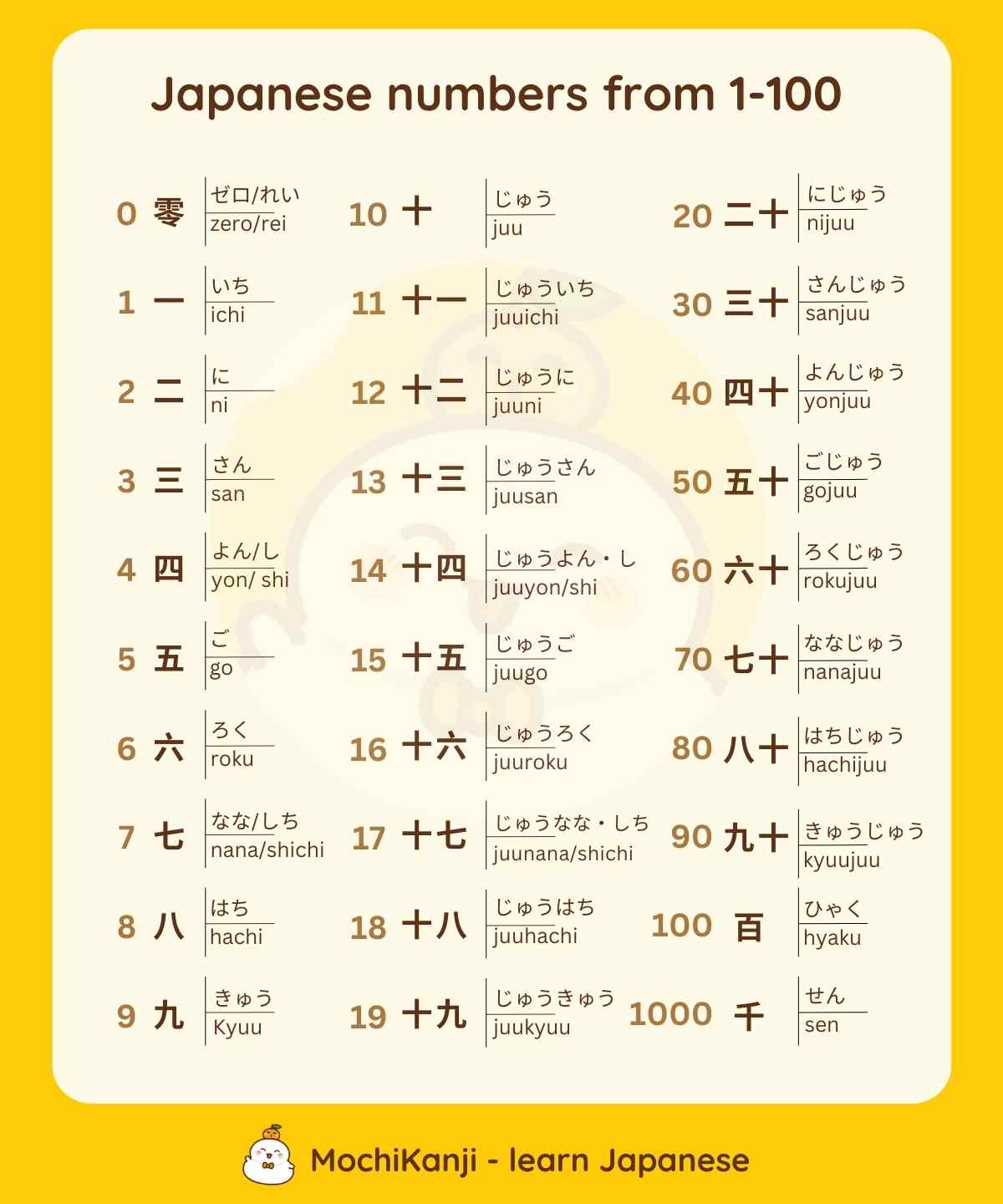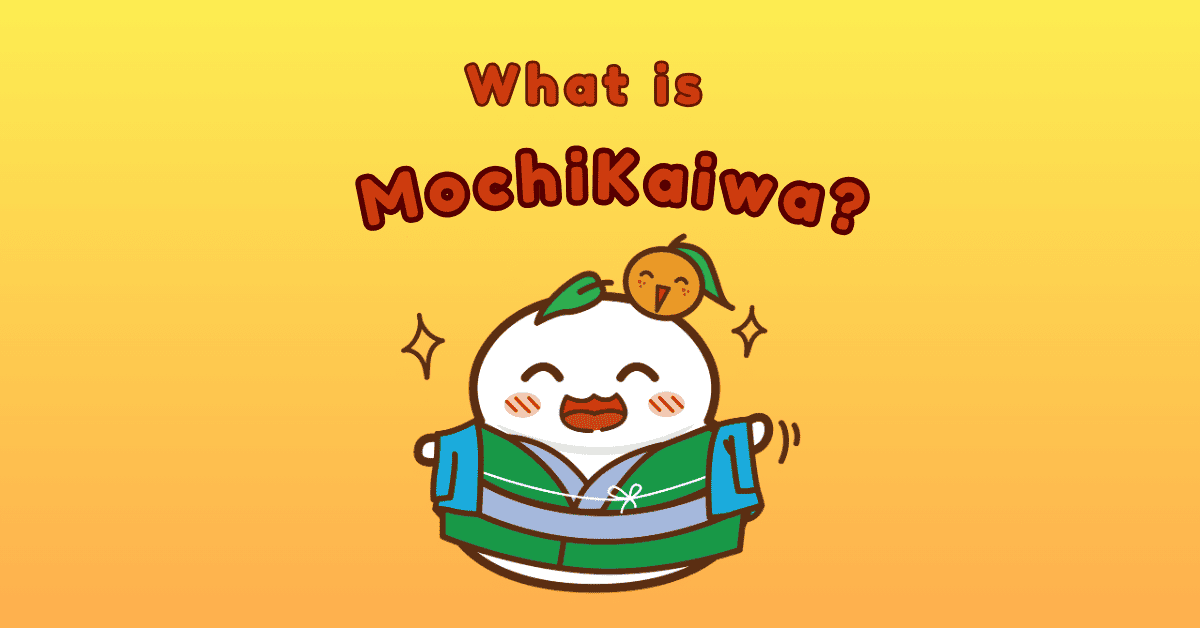Learning how to count in Japanese is a fundamental skill that can help you in everyday situations, such as shopping, telling time, and understanding quantities. The Japanese numerical system is intriguing and learning it can give you a deeper insight into the culture and language. Here, we’ll explore the basics of counting in Japanese, including the names for numbers from 1 to 100 and the unique way that larger numbers are handled.
- The importance of numbers in Japanese
- Learning numbers through songs
- Counting from 1 to 10 in Japanese
- Counting from 10 to 100 in Japanese
- Larger Numbers and how Japanese dividing Zeroes
- More about Japanese counters
- Lucky and unlucky numbers in Japanese
- Learning how to Count in Japanese
- FAQs

The importance of numbers in Japanese
Numbers play a vital role in the Japanese language, not only for counting but also for understanding various aspects of daily life and culture. Japanese has a unique counting system that includes different words and counters for counting objects, people, animals, and even time. For instance, counting people uses “nin,” while counting small animals uses “hiki.” Mastering these counters is essential for fluency.
Additionally, numbers are heavily integrated into dates, addresses, prices, and ages, making them indispensable for everyday communication. Learning the correct way to count and use numbers helps avoid misunderstandings and allows for more natural conversations.
In business and formal contexts, accurate use of numbers is crucial, as they can affect precision and professionalism in communication. Whether you’re discussing quantities, prices, or dates, a solid understanding of Japanese numbers is essential for effective interaction in both casual and professional settings.
Learning numbers through songs
Learning numbers becomes fun and easy with songs. Catchy tunes and repetition help you remember and practice counting naturally. It’s a playful way to learn while enjoying music!
Counting from 1 to 10 in Japanese
Here’s a simple table to help you learn the Japanese numbers from 1 to 10. It includes the Kanji (Japanese characters used for numbers), Hiragana (the phonetic Japanese script), Romaji (the Latin alphabet transcription of Japanese words), and the English meaning.
| Kanji | Hiragana | Romaji | Meaning |
|---|---|---|---|
| 一 | いち | ichi | 1 |
| 二 | に | ni | 2 |
| 三 | さん | san | 3 |
| 四 | し/よん | shi/yon | 4 |
| 五 | ご | go | 5 |
| 六 | ろく | roku | 6 |
| 七 | しち/なな | shichi/nana | 7 |
| 八 | はち | hachi | 8 |
| 九 | きゅう/く | kyuu/ku | 9 |
| 十 | じゅう | juu | 10 |
Note that some numbers like 4, 7, and 9 have two possible readings. “Shi” for 4 and “shichi” for 7 are less commonly used in everyday conversation due to their similarity in pronunciation to the word for death. Instead, “yon” and “nana” are preferred.
Counting from 10 to 100 in Japanese
Once you’ve mastered 1 to 10, counting further up to 100 is straightforward in Japanese. Here’s a breakdown of the tens:
| Kanji | Hiragana | Romaji | Meaning |
|---|---|---|---|
| 十 | じゅう | juu | 10 |
| 二十 | にじゅう | nijuu | 20 |
| 三十 | さんじゅう | sanjuu | 30 |
| 四十 | よんじゅう | yonjuu | 40 |
| 五十 | ごじゅう | gojuu | 50 |
| 六十 | ろくじゅう | rokujuu | 60 |
| 七十 | ななじゅう | nanajuu | 70 |
| 八十 | はちじゅう | hachijuu | 80 |
| 九十 | きゅうじゅう | kyuujuu | 90 |
| 百 | ひやく | hyaku | 100 |
The Japanese vocabulary course offers essential terms related to counting objects, quantities, and measurement units. Save these words and review them using MochiKanji’s Golden Time feature to enhance your usage and retention effectively.
Larger Numbers and Dividing Zeroes
Japanese numbers get interesting as they grow larger. The system changes every four zeroes, unlike Western systems which change every three zeroes. Here’s how:
- 千 (sen) – 1,000
- 万 (man) – 10,000 (Note: This is where it shifts from the Western thousand system.)
- 億 (oku) – 100,000,000
The system uses units of ten thousand (万), then a hundred million (億), which is different from the Western million. This aspect of the Japanese numerical system often confuses learners initially but becomes straightforward with practice.
More about Japanese counters
In English, we simply add a number before most nouns to indicate quantity, such as “three apples” or “five cars.” However, in Japanese, each category of items or actions often has its own specific counterword that must be used with numbers.
Here are a few examples of Japanese counters:
- 一人 (hitori), 二人 (futari), 三人 (sannin) – These counters are used specifically for counting people. Notice that the counter changes after two, which is a unique feature for people-counting in Japanese.
- 一枚 (ichimai), 二枚 (nimai), 三枚 (sanmai) – Used for flat objects, such as sheets of paper or pieces of clothing.
- 一台 (ichidai), 二台 (nidai), 三台 (sandai) – This counter is used for machinery and vehicles, such as cars and computers.
- 一匹 (ippiki), 二匹 (nihiki), 三匹 (sanbiki) – Used for small animalsand fish.
Each of these counters is attached to a number and often changes its pronunciation based on the number it precedes, adding an additional layer of complexity.
Some Japanese counters you need to know
People
人 (nin): General counter for people, but note the irregular forms for one and two people: 一人 (hitori) and 二人 (futari).
Flat Objects
枚 (mai): Used for flat and thin objects like sheets of paper, plates, or shirts.
Large Animals
頭 (tou): Used for large animals, such as cattle and horses.
Small Animals
匹 (hiki): Used for small animals and insects. Note the pronunciation changes with numbers.
Long, Cylindrical Objects
本 (hon): Used for long, cylindrical objects such as bottles, baseball bats, and trees.
Machines and Vehicles
台 (dai): Used for machines and vehicles like cars, computers, and air conditioners.
Books
冊 (satsu): Used specifically for counting bound volumes like books and notebooks.
Drinks and Soups
杯 (hai): Used for counting cupfuls or glassfuls of drinks, bowls of soup, or small containers.
Floors of Buildings
階 (kai): Used for counting the floors or stories of a building.
Pieces of Furniture
脚 (kyaku): Used for pieces of furniture with legs, like chairs and tables.
Events or Occurrences
回 (kai): Used to count occurrences or number of times an event happens.
Pieces or Items
個 (ko): A general counter for pieces or items not covered by more specific counters.
For learners of Japanese, mastering the system of counters can be quite challenging. This is because of there are over a hundred counters in Japanese, and each category of nouns might have its own counter. Learning which counters to use in each context requires practice and exposure. Moreover, Some counters have irregular forms or change pronunciation in ways that aren’t immediately intuitive, especially with certain numbers. Last but not least, Counters can reflect cultural categories that are not obvious to non-natives. For example, long, cylindrical objects like bottles or umbrellas each have their own counters.
Lucky and unlucky numbers in Japanese
In Japanese culture, numbers are believed to carry specific meanings, with some considered lucky and others unlucky. These associations often stem from the way the numbers sound, especially in relation to words for death or suffering, as well as positive meanings tied to prosperity and happiness.
Unlucky numbers:
4 (四, shi) – This number is considered unlucky because “shi” sounds similar to the word for death (死, shi). As a result, the number 4 is often avoided in hospitals, hotels, and even apartment numbers.
9 (九, ku) – The number 9 is also seen as unlucky because “ku” sounds like “苦” (ku), meaning suffering or pain. It’s another number people tend to avoid, especially in contexts related to health and well-being.
Lucky numbers:
7 (七, nana) – The number 7 is regarded as lucky in Japanese culture, symbolizing good fortune and happiness. This is reflected in various traditions, such as the “Shichi-Go-San” festival for children aged 7, 5, and 3, and the celebration of Tanabata, the Star Festival, on July 7th.
8 (八, hachi) – The number 8 is considered very lucky because the kanji for 8 (八) represents an expanding shape, symbolizing prosperity and growth. The belief is that this number brings success and financial fortune.
Learning how to Count in Japanese
To effectively learn to count in Japanese, consider these strategies:
- Practice Regularly: Use flashcards, apps, or write numbers down to memorize their Kanji, Hiragana, and Romaji forms. The most recommended app for learning such new words with an excellent learning and practicing system is MochiKanji. With simple lessons and a great learning method Spaced repetition system, MochiKanji will walk you through all numbers in Japanese in no time. Moreover, the app also has a separate writing section where you can practice writing Kanji of numbers.
- Use Practical Examples: Apply numbers in daily situations like counting items, reading prices, or during exercises.
- Engage with Media: Listen to Japanese songs, and watch anime, or children’s shows where numbers are used in dialogue.

Counting numbers are an essential part of Japanese language and culture. To learn quickly and retain information longer, you can use the MochiKanji app. MochiKanji offers courses ranging from basic to advanced, including counting numbers in the JLPT N5 course. The app features lessons that progress from easy to difficult, with images and exercises to help you master the use of numbers in Japanese.
Start your free trial now!
Counting in Japanese is not only a useful skill but also a fun way to engage with the language. With regular practice and usage, you’ll find that numbers become second nature to you as you continue your Japanese learning journey.
FAQs
How to count 1 to 10 in Japanese?
To count from 1 to 10 in Japanese, you use the following words:
- 一 (いち, ichi)
- 六 (ろく, roku)
- 七 (しち/なな, shichi/nana)
- 八 (はち, hachi)
- 九 (きゅう/く, kyuu/ku)
- 十 (じゅう, juu)
Is 7 Nana or Shichi?
Both “nana” (なな) and “shichi” (しち) are correct for the number 7 in Japanese. “Nana” is often used in everyday conversation, while “shichi” is used in more formal or traditional contexts.
Is 4 shi or yon?
Both “shi” (し) and “yon” (よん) are used for the number 4 in Japanese. “Shi” is also used in certain contexts, such as counting or medical terminology, but “yon” is more commonly used in everyday situations to avoid confusion with the word for death, which is also “shi.”
How do you say 1 to 20 numbers in Japanese?
Here’s how to say the numbers from 1 to 20 in Japanese:
- 一 (いち, ichi)
- 二 (に, ni)
- 三 (さん, san)
- 四 (し/よん, shi/yon)
- 五 (ご, go)
- 六 (ろく, roku)
- 七 (しち/なな, shichi/nana)
- 八 (はち, hachi)
- 九 (きゅう/く, kyuu/ku)
- 十 (じゅう, juu)
- 十一 (じゅういち, juuichi)
- 十二 (じゅうに, juuni)
- 十三 (じゅうさん, juusan)
- 十四 (じゅうし/じゅうよん, juushi/juuyon)
- 十五 (じゅうご, juugo)
- 十六 (じゅうろく, juuroku)
- 十七 (じゅうしち/じゅうなな, juushichi/juunana)
- 十八 (じゅうはち, juuhachi)
- 十九 (じゅうきゅう/じゅうく, juukyu/juuku)
- 二十 (にじゅう, nijuu)






